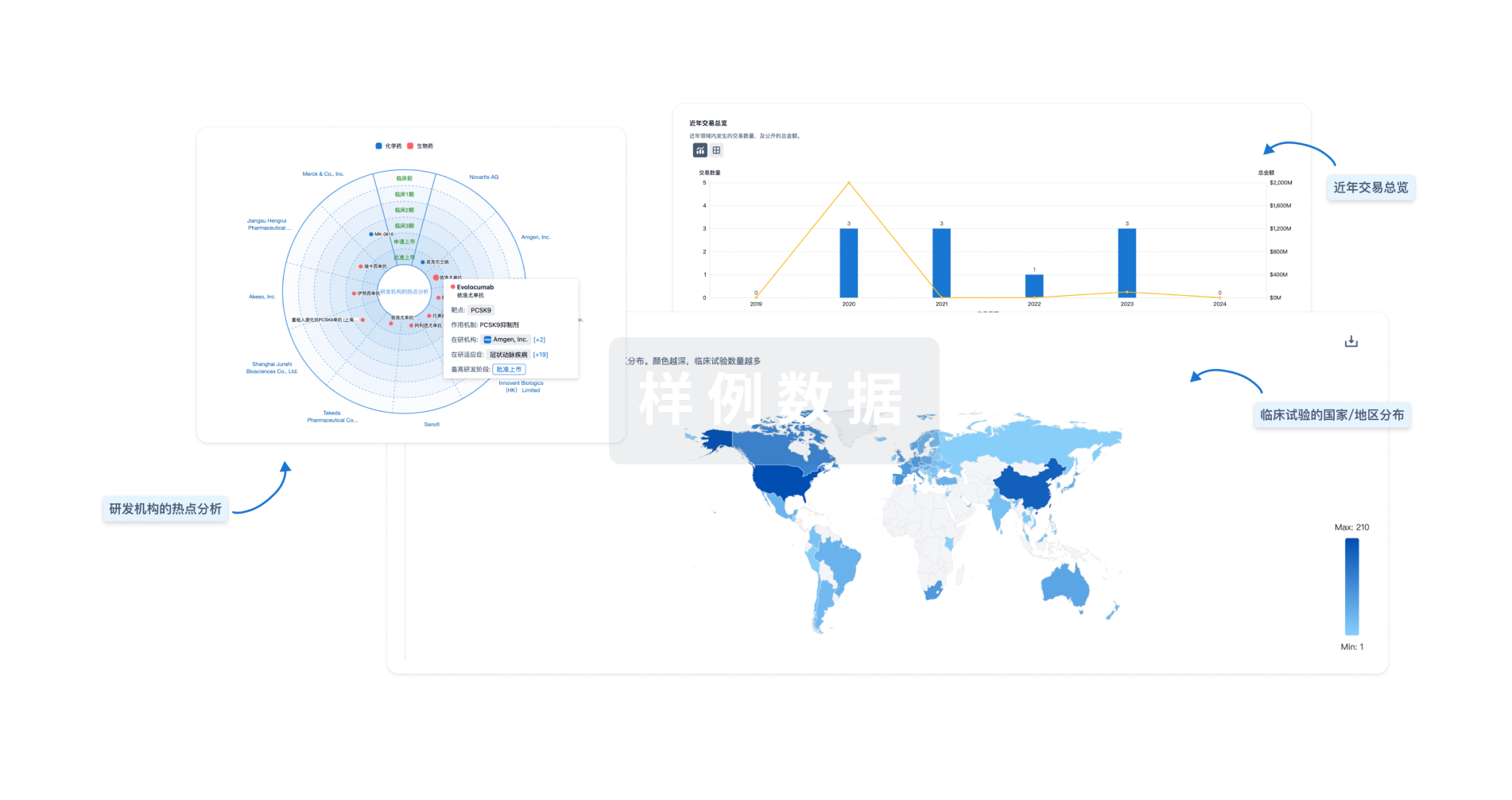预约演示
更新于:2025-05-07
CDK5
更新于:2025-05-07
基本信息
别名 CDK5、CDKN5、Cell division protein kinase 5 + [8] |
简介 Proline-directed serine/threonine-protein kinase essential for neuronal cell cycle arrest and differentiation and may be involved in apoptotic cell death in neuronal diseases by triggering abortive cell cycle re-entry. Interacts with D1 and D3-type G1 cyclins. Phosphorylates SRC, NOS3, VIM/vimentin, p35/CDK5R1, MEF2A, SIPA1L1, SH3GLB1, PXN, PAK1, MCAM/MUC18, SEPT5, SYN1, DNM1, AMPH, SYNJ1, CDK16, RAC1, RHOA, CDC42, TONEBP/NFAT5, MAPT/TAU, MAP1B, histone H1, p53/TP53, HDAC1, APEX1, PTK2/FAK1, huntingtin/HTT, ATM, MAP2, NEFH and NEFM. Regulates several neuronal development and physiological processes including neuronal survival, migration and differentiation, axonal and neurite growth, synaptogenesis, oligodendrocyte differentiation, synaptic plasticity and neurotransmission, by phosphorylating key proteins. Negatively regulates the CACNA1B/CAV2.2 -mediated Ca(2+) release probability at hippocampal neuronal soma and synaptic terminals (By similarity). Activated by interaction with CDK5R1 (p35) and CDK5R2 (p39), especially in postmitotic neurons, and promotes CDK5R1 (p35) expression in an autostimulation loop. Phosphorylates many downstream substrates such as Rho and Ras family small GTPases (e.g. PAK1, RAC1, RHOA, CDC42) or microtubule-binding proteins (e.g. MAPT/TAU, MAP2, MAP1B), and modulates actin dynamics to regulate neurite growth and/or spine morphogenesis. Phosphorylates also exocytosis associated proteins such as MCAM/MUC18, SEPT5, SYN1, and CDK16/PCTAIRE1 as well as endocytosis associated proteins such as DNM1, AMPH and SYNJ1 at synaptic terminals. In the mature central nervous system (CNS), regulates neurotransmitter movements by phosphorylating substrates associated with neurotransmitter release and synapse plasticity; synaptic vesicle exocytosis, vesicles fusion with the presynaptic membrane, and endocytosis. Promotes cell survival by activating anti-apoptotic proteins BCL2 and STAT3, and negatively regulating of JNK3/MAPK10 activity. Phosphorylation of p53/TP53 in response to genotoxic and oxidative stresses enhances its stabilization by preventing ubiquitin ligase-mediated proteasomal degradation, and induces transactivation of p53/TP53 target genes, thus regulating apoptosis. Phosphorylation of p35/CDK5R1 enhances its stabilization by preventing calpain-mediated proteolysis producing p25/CDK5R1 and avoiding ubiquitin ligase-mediated proteasomal degradation. During aberrant cell-cycle activity and DNA damage, p25/CDK5 activity elicits cell-cycle activity and double-strand DNA breaks that precedes neuronal death by deregulating HDAC1. DNA damage triggered phosphorylation of huntingtin/HTT in nuclei of neurons protects neurons against polyglutamine expansion as well as DNA damage mediated toxicity. Phosphorylation of PXN reduces its interaction with PTK2/FAK1 in matrix-cell focal adhesions (MCFA) during oligodendrocytes (OLs) differentiation. Negative regulator of Wnt/beta-catenin signaling pathway. Activator of the GAIT (IFN-gamma-activated inhibitor of translation) pathway, which suppresses expression of a post-transcriptional regulon of proinflammatory genes in myeloid cells; phosphorylates the linker domain of glutamyl-prolyl tRNA synthetase (EPRS) in a IFN-gamma-dependent manner, the initial event in assembly of the GAIT complex. Phosphorylation of SH3GLB1 is required for autophagy induction in starved neurons. Phosphorylation of TONEBP/NFAT5 in response to osmotic stress mediates its rapid nuclear localization. MEF2 is inactivated by phosphorylation in nucleus in response to neurotoxin, thus leading to neuronal apoptosis. APEX1 AP-endodeoxyribonuclease is repressed by phosphorylation, resulting in accumulation of DNA damage and contributing to neuronal death. NOS3 phosphorylation down regulates NOS3-derived nitrite (NO) levels. SRC phosphorylation mediates its ubiquitin-dependent degradation and thus leads to cytoskeletal reorganization. May regulate endothelial cell migration and angiogenesis via the modulation of lamellipodia formation. Involved in dendritic spine morphogenesis by mediating the EFNA1-EPHA4 signaling. The complex p35/CDK5 participates in the regulation of the circadian clock by modulating the function of CLOCK protein: phosphorylates CLOCK at 'Thr-451' and 'Thr-461' and regulates the transcriptional activity of the CLOCK-BMAL1 heterodimer in association with altered stability and subcellular distribution. |
关联
17
项与 CDK5 相关的药物作用机制 CDK2抑制剂 [+5] |
在研机构 |
原研机构 |
最高研发阶段临床2期 |
首次获批国家/地区- |
首次获批日期1800-01-20 |
作用机制 CDK1抑制剂 [+3] |
在研适应症 |
最高研发阶段临床前 |
首次获批国家/地区- |
首次获批日期1800-01-20 |
靶点 |
作用机制 CDK5抑制剂 |
在研适应症 |
非在研适应症- |
最高研发阶段临床前 |
首次获批国家/地区- |
首次获批日期1800-01-20 |
27
项与 CDK5 相关的临床试验NCT05588141
A Phase I/II Study of Zotiraciclib for Recurrent Malignant Gliomas With Isocitrate Dehydrogenase 1 or 2 (IDH1 or IDH2) Mutations
Background:
Diffuse gliomas are tumors that affect the brain and spinal cord. Gliomas that develop in people with certain gene mutations (IDH1 or IDH2) are especially aggressive. Better treatments are needed.
Objective:
To see if a study drug (zotiraciclib) is effective in people with recurrent diffuse gliomas who have IDH1 or IDH2 mutations.
Eligibility:
People aged 15 years and older with diffuse gliomas that returned after treatment. They must also have mutations in the IDH1 or IDH2 genes.
Design:
Participants will be screened. They will have a physical exam with blood and urine tests. They will have tests of their heart function. They will have an MRI of their brain. A new biopsy may be needed if previous results are not available.
Zotiraciclib is a capsule taken by mouth with a glass of water. Participants will take the drug at home on days 1, 4, 8, 11, 15, and 18 of a 28-day cycle. They may also be given medications to prevent side effects of the study drug. The schedule for taking the study drug may vary for participants who will undergo surgery.
Participants will be given a medication diary for each cycle. They will write down the date and time of each dose of the study drug.
Participants will visit the clinic about once a month. They will have a physical exam, blood tests, and tests to evaluate their heart function. An MRI of the brain will be repeated every 8 weeks.
Participants may remain in the study for up to 18 cycles (1.5 years).
Diffuse gliomas are tumors that affect the brain and spinal cord. Gliomas that develop in people with certain gene mutations (IDH1 or IDH2) are especially aggressive. Better treatments are needed.
Objective:
To see if a study drug (zotiraciclib) is effective in people with recurrent diffuse gliomas who have IDH1 or IDH2 mutations.
Eligibility:
People aged 15 years and older with diffuse gliomas that returned after treatment. They must also have mutations in the IDH1 or IDH2 genes.
Design:
Participants will be screened. They will have a physical exam with blood and urine tests. They will have tests of their heart function. They will have an MRI of their brain. A new biopsy may be needed if previous results are not available.
Zotiraciclib is a capsule taken by mouth with a glass of water. Participants will take the drug at home on days 1, 4, 8, 11, 15, and 18 of a 28-day cycle. They may also be given medications to prevent side effects of the study drug. The schedule for taking the study drug may vary for participants who will undergo surgery.
Participants will be given a medication diary for each cycle. They will write down the date and time of each dose of the study drug.
Participants will visit the clinic about once a month. They will have a physical exam, blood tests, and tests to evaluate their heart function. An MRI of the brain will be repeated every 8 weeks.
Participants may remain in the study for up to 18 cycles (1.5 years).
开始日期2023-05-16 |
申办/合作机构 |
CTR20182002
口服TG02胶囊治疗TMZ治疗失败的复发/进展性高级别脑胶质瘤患者单中心、剂量递增、开放I期临床研究
主要目标:探索剂量限制性毒性(DLT)和最大耐受剂量(MTD) 次要目标:1、评估研究药物的药代动力学参数;2、评估研究药物的心脏安全性;3、初步评估研究药物抗肿瘤的有效性。 探索性目标:探索肿瘤组织myc和mcl-1表达与临床疗效的关系。
开始日期2019-04-24 |
申办/合作机构 |
NCT03904628
Single-center, Dose Escalation, Open Phase I Clinical Study of Oral TG02 Capsule in the Treatment of Recurrent / Progressive High-grade Glioma Patients With Failed TMZ Treatment
The aim of the study was to explore the dose-limiting toxicity (DLT) and the maximum tolerable dose (MTD) of oral administration of TG02 capsules twice a week for 4 weeks.
开始日期2019-03-22 |
申办/合作机构 |
100 项与 CDK5 相关的临床结果
登录后查看更多信息
100 项与 CDK5 相关的转化医学
登录后查看更多信息
0 项与 CDK5 相关的专利(医药)
登录后查看更多信息
3,170
项与 CDK5 相关的文献(医药)2025-12-01·Molecular Biology Reports
CDK5: Insights into its roles in diseases
Review
作者: Zhou, Yali ; He, Yi ; Jiang, Tingting ; Wu, Yongli ; Yan, Jianguo ; Zhang, Chong ; Wang, Jiahui ; Zhou, Dongsheng
2025-12-01·Journal of Computer-Aided Molecular Design
Anticancer potential of novel benzothiazolyl piperidine-3-carboxamide derivatives as CDKs and VEGFR2 multi-target kinase inhibitors
Article
作者: Altamimi, Abdulmalik S A ; Aldakhil, Taibah ; Alossaimi, Manal A ; Alamri, Mubarak A ; Alqahtani, Safar M ; Afzal, Obaid ; Altharawi, Ali ; Alabbas, Alhumaidi
2025-08-01·Computational Biology and Chemistry
Phytoflavonoids as alternative therapeutic effect for melanoma: Integrative Network pharmacology, molecular dynamics and drug-likeness profiling for lead discovery
Article
作者: Panda, Pritipadma ; Prajapati, Manoj Kumar ; Mittal, Abhilasha
35
项与 CDK5 相关的新闻(医药)2025-04-07
·肿瘤界
点击蓝字 关注我们2025年4月3日,复旦大学附属肿瘤医院院长虞先濬教授团队联合北京大学肿瘤医院、中国科学院上海药物研究所、上海长海医院、中国科学院分子细胞科学卓越创新中心,历时五年研究,成功绘制全球首张无功能性胰腺神经内分泌瘤多组学全景图谱,并根据图谱突破性提出这种“沉默肿瘤”的分子分型框架、预后模型和靶向-免疫治疗新策略,为临床精准诊疗提供了重要依据。国际顶级肿瘤学期刊《癌细胞》(Cancer Cell)同日发表该项重要研究成果,题为“Proteogenomic characterization of non-functional pancreatic neuroendocrine tumors unravels clinically relevant subgroups”,影响因子为48.8分。“沉默”的无功能性胰腺神经内分泌瘤缺乏精准治疗依据神经内分泌肿瘤起源于神经内分泌细胞,这种细胞遍布人体各处,胃、肠、胰腺等消化系统最常见,在我国患者中发生在胰腺部位的最多。胰腺神经内分泌瘤是发生在胰腺的第二大常见肿瘤,约90%为无功能性。这类无功能性胰腺神经内分泌瘤早期没有症状,因而也被称作“沉默的肿瘤”。其中约半数患者确诊时已发生转移,特别是肝转移,且接受根治手术后也有不少患者容易复发,在临床上缺乏有效预测预后的分子标志物,综合治疗疗效有待提高。更关键的是,胰腺神经内分泌瘤的复杂性如同一部加密的“天书”,其高度异质性和治疗困境长期困扰医学界,进而导致无功能性的胰腺神经内分泌瘤缺乏精准治疗依据,患者术后是否需要辅助治疗和随访周期并不确定。此外,现有的药物治疗方案,多数仅能改善患者的无进展生存期,对总体生存期的改善有限。因此,亟需对无功能性的胰腺神经内分泌瘤的分子机制进行深入研究。绘制全球首张“全息图谱”,破解沉默肿瘤“终极密码”历时五年攻关,虞先濬教授团队联合多中心研究团队,整合基因组、转录组、蛋白质组和磷酸化修饰组四种组学数据,绘制了全球首个无功能性胰腺神经内分泌瘤蛋白基因组学全景分子图谱。团队通过对108例中国无功能性胰腺神经内分泌瘤患者开展全外显子组、转录组、蛋白质组及磷酸化修饰组的多维度整合分析,绘制出全景分子图谱,揭示了MEN1、ATRX、DAXX基因突变通过干扰染色质结构稳定性和激活mTOR通路驱动肿瘤恶性演进的机制。研究团队还通过MEN1基因条件性敲除小鼠模型,验证了MEN1缺失触发代谢重编程和增殖信号交叉激活的恶性循环,从而导致染色体分离至关重要的CENPV蛋白下调,填补了该领域机制研究的空白。另外,CDK5、WASL等基因的拷贝数扩增被发现为无功能性胰腺神经内分泌瘤生长的驱动因素,有望成为靶向治疗的潜在“靶标”。筛选“靶标”建立预后模型,有效预测患者生存预后研究团队发现,在无功能性胰腺神经内分泌瘤患者的临床诊疗中,传统肿瘤分期及病理分级难以满足个体化治疗的需求。为了解决这一临床困境,研究团队基于海量蛋白质组数据,利用前期研发的ReProMSig平台基于人工智能算法筛选出GNAO1、INA、VCAN三个蛋白质,构建了预后标志物特征谱和预后模型,为无功能性胰腺神经内分泌瘤的预后判断提供了重要工具。据介绍,该模型在包含345例患者的四组独立队列中均展现出优良的预测效能和区分效果:高危患者五年生存率仅为51.4%,而低危组则高达97.8%。更具临床意义的是,研究团队还证实分泌蛋白VCAN在患者血浆中的浓度与肿瘤进展显著相关,这一发现有望推动诊疗模式从“有创组织活检”向“无创血液检测”跨越。提出“四分型”策略,开启个体化精准治疗时代研究团队进一步通过蛋白质组学特征聚类分析,将无功能性胰腺神经内分泌瘤患者划分为四种分子亚型,为临床治疗提供了“按图索骥”的精准路线。其中C1亚型的肿瘤以免疫抑制微环境和EMT通路激活为特征,患者预后最差,急需探索免疫联合疗法;C2亚型表现出异常活跃的氧化磷酸化活性;C3亚型由MYC异常激活和失控的细胞周期信号主导;C4亚型则在VHL突变驱动下形成独特的缺氧生态。研究团队后续的药物研究证实了“四分型”的准确性。基于各亚型特异激活的蛋白激酶和表达/活性上调蛋白,团队利用患者来源类器官(PDO)开展了药物筛选并利用患者来源肿瘤异种移植模型(PDX)进行验证,证实CDK5抑制剂可抑制四种分子亚型的肿瘤生长;钙离子通道阻滞剂(如心血管疾病经典药物盐酸胺碘酮)与CDK5抑制剂两药联用在C2亚型中表现出更好的抑瘤效果;目前临床运用的mTOR抑制剂可较好抑制C4亚型肿瘤。这些证据显示,基于“四分型”的“分型而治”策略,为个体化精准治疗提供了科学依据。复旦大学附属肿瘤医院院长虞先濬教授表示,该研究是国际上首次大规模对胰腺神经内分泌瘤临床队列开展的多组学综合分析,研究成果为无功能性的胰腺神经内分泌瘤的发病机制解析、预后预测、分子分型及个体化治疗提供了坚实的理论依据,有望推动胰腺神经内分泌瘤研究领域的快速发展。据了解,近年来,虞先濬教授带领团队不断探索和技术创新,从胰腺神经内分泌瘤的手术方式选择、淋巴结清扫范围以及复发转移预测三方面入手,形成了完善的胰腺神经内分泌瘤个体化治疗新策略,实现了术前精准预测淋巴结转移风险,术中肿瘤微创精准切除,规范淋巴结清扫范围,最大程度保留胰腺功能,术后甄别高危复发转移人群,进行个体化随访治疗。系列研究成果获得了首届“上海市级医院临床创新奖”等多项荣誉。声明:本文由“肿瘤界”整理与汇编,欢迎分享转载,如需使用本文内容,请务必注明出处。来源:复旦大学附属肿瘤医院官网原标题:绘制全球首张“全息图谱”!我国专家破解“沉默肿瘤”诊疗困局编辑:lagertha审核:南星
免疫疗法临床研究
2025-03-03
·汇聚南药
孙建国
博士,中国药科大学研究员,博士生导师,专业方向为药物代谢动力学,主要从事创新药物体内和体外吸收及代谢特性、药物相互作用、生理药代动力学及中药药代动力学研究。先后赴新西兰奥塔哥大学药学院和美国华盛顿大学药学院作访问学者,2010 年赴新西兰参加科技部组织的“中新科学家交流计划”,2011 年被评为江苏省“333 高层次人才培养工程”第三梯队培养对象并获得政府留学奖学金。担任 J Chromatogr B, Xenobiotica, Phytomedicine, 《药学进展》《中国新药杂志》等杂志审稿人。
先后主持完成了 4 项江苏省自然科学基金,3 项国家自然科学基金,1 项国家重点研发计划,主持多项国家重大科研项目子课题,参加多项国家重大科研项目。近年来发表论文 40 余篇,其中以第一作者或通讯作者发表论文 20 余篇(其中 SCI 论文 18 篇),申请专利 6 项,授权 4 项。曾获 2023 年度第三届全国创新争先团队奖(排名第 5),国家科技进步二等奖(排名第 7),江苏省科技进步一等奖 3 项(排名第 4/6/6)。与企业共同合作获得新药临床批件 5 项,负责完成的药代动力学研究支持企业获得新药证书多项。
细胞周期蛋白依赖性激酶家族的研究进展 PPS
李雪华 1, 2,孙继红 2,孙建国 1*
(1. 中国药科大学药物代谢动力学重点实验室,江苏 南京 210009;2. 南京圣和药业股份有限公司,江苏 南京 210038)
[摘要] 细胞周期蛋白依赖性激酶(cyclin-dependent kinase,CDK)是调控细胞周期的核心分子,其家族的亚型存在于细胞周期的各个阶段。CDK 家族成员根据其发挥功能不同主要分为三大类:细胞周期调节因子、转录调节因子以及功能多样或尚未定义的调节器。由于不同类型肿瘤的发生都与细胞周期调控失调有关,所以 CDK 家族成为了抗肿瘤药物开发的热门靶点。目前已上市的 CDK 靶向抑制剂均为 CDK4/6 抑制剂,而作用于其余 CDK 靶点的药物也在持续跟进中,期待在不久的将来会有更多的药物问世。现阶段也有一些研发机构致力于开发作用于非肿瘤病症的 CDK 抑制剂,但这些药物多处于临床前研发阶段。通过对已发现的 CDK 家族的成员进行总结,希望能为后续 CDK 的研究提供一定的参考价值。
细胞周期是细胞生命活动的基本过程,它控制着细胞从静止期转向生长增殖期的过程。细胞周期包括 4 个时期:G1 期(DNA 合成前期)、S 期(DNA合成期)、G2 期(细胞分裂前期)和 M 期(细胞分裂期)。细胞分裂发生在各种生命过程之中,是最基本的生物活动之一,细胞在分裂的过程中会受到不同蛋白酶的调节,细胞周期蛋白依赖性激酶(cyclin-dependent kinase,CDK)便是其中的一种。CDK 属于丝氨酸/苏氨酸家族,目前共有 20 种不同的 CDK 被发现 [1]。不同的 CDK 通过与其相应的细胞周期蛋白(cyclin)结合从而发挥作用。其作为细胞分裂过程中关键的蛋白激酶,与人类的生活息息相关,目前已成为了各大研究所与医药公司研究的热门靶点。
1
细胞周期蛋白依赖性激酶概述
目前在人体内共有 20 种不同的 CDK 被发现,CDK 家族中绝大多数成员的蛋白质长度低于 500 aa,且发挥主要功能的激酶结构域占整个氨基酸序列的绝大部分,而转录调节剂CDK12、CDK13 与其他成员有较大差别。CDKs 通过与 cyclin 结合后才会发挥相应作用,根据其功能可以分为三大类 [2]:1)细胞周期的调节因子,CDK1、 2、 3、 4 和 6;2)转 录调节剂,CDK7、8、9、12、13 和 19;3) 功能多样或尚未定义的调节器,CDK5、10、11、14、15、16、17、18 和 20。
1.1 细胞周期的调节因子
负责调控细胞周期的 CDKs 主要通过与不同的cyclin 结合进而作用于细胞周期的各个阶段(见图1)。除作用于有丝分裂外,部分 CDKs 也可影响减数分裂的进程。
1.1.1 CDK1 CDK1 是与细胞有丝分裂进展相关的关键因素,能够与不同的 cyclin 结合,结合后其功能足以调节细胞分裂所需的所有步骤,继而影响细胞的增殖,且对细胞凋亡也产生一定影响 [3]。近年来,随着人们对 CDK1 的相关研究增多,CDK1 越来越多的功能已被发现。线粒体动力学、线粒体蛋白内流以及生物能量学中都有 CDK1 的参与 [4]。有研究表明,CDK1 对哺乳动物的卵子成熟有一定影响,可以提高体外受精的成功率,自噬泡的形成过程中也有 CDK1 的参与。CDK1 也参与抗病毒信号通路,CDK1 在病原感染的过程中可能会被病原利用,进而会产生协助病毒复制或免疫逃逸的作用 [5]。
1.1.2 CDK2 CDK2 在体内与 cyclin 结合形成二聚体后,通过发生磷酸化和去磷酸化,促进细胞通过 G1 期进入 S 期。除对细胞增殖的影响外,CDK2 在细胞分化、细胞凋亡以及多种疾病的发生发展中也起到一定作用。有研究报道,CDK2 通过参与磷脂酰肌醇 3-激酶(phosphoinositide 3-kinase,PI3K)/ 蛋白激酶 B(protein kinase B,PKB,又称 AKT)信号通路,促进肿瘤细胞的增殖,而其表达失衡,是导致恶性肿瘤的发生与发展的因素之一。CDK2 参与高等真核生物的 DNA 复制,磷酸化复制前复合物的几个组分,在协调细胞中心体复制周期中发挥重要作用,且其是减数分裂所必需的 CDK [6]。
1.1.3 CDK3 CDK3 是细胞周期调控机制的核心,其在多种人类肿瘤细胞系和肿瘤组织中高表达,但在正常组织和细胞中的活性极低,所以 CDK3 与一些肿瘤的发生和发展密切相关,其表达可能为肿瘤的早期诊断和治疗提供新思路 [7]。截至目前,对CDK3 的研究尚不充分,其生物学功能和调节细胞周期的机制有待于进一步开发。
1.1.4 CDK4 CDK4 是调节细胞周期的核心因子之一,与 Cyclin D 结合后,通过调节 RB 磷酸化,使RB 在 G1后期被其他 CDK 灭活,并从 RB 约束中释放 E2F,促进细胞由 G1期向 S 期推进 [8](见图 2)。研究表明,CDK4 是脂肪细胞胰岛素应答的重要介质,胰岛素激活 Cyclin D1-CDK4 复合物,在赖氨酸乙酰转移酶 2A(lysine acetyltransferase 2A,KAT2A)的作用下使得糖异生基因的表达受到抑制,从而抑制肝中葡萄糖的产生 [9]。除葡萄糖代谢外,CDK4 和 Cyclin D3 还通过腺苷酸活化蛋白激酶 α2(adenosine 5-monophosphate activated protein kinase α2,AMPKα2)亚基的磷酸化对植物组织进行负调节,在厌氧糖酵解和脂肪酸氧化中发挥作用 [10]。CDK4表达也是三阴性乳腺癌的预后指标。
1.1.5 CDK6 CDK6 与 CDK4 是高度同源的细胞周期激酶,通过与 Cyclin D(D1、D2 和 D3)形成复合物,促进细胞在 G1期的进展。同 CDK4 类似,CDK6-Cyclin D 复合物能够使 RB 磷酸化,进而从RB 介导的抑制中释放 E2F [11](见图 2)。CDK6也在造血中起重要作用,其丢失会导致淋巴细胞轻度贫血,胸腺萎缩和 G1进展延迟,在造血干细胞(hematopoietic stem cell,HSC)中,CDK6 的缺失会导致干细胞活化延迟 [12]。有研究表明,Yes相关蛋白(Yes associated protein,YAP)可以改善CDK6 的信号通路,进而预防星形胶质细胞过早衰老和阿尔茨海默病(Alzheimer, s disease,AD)认知能力下降 [13]。
1.2 转录调节剂
调控转录相关的 CDKs 主要通过与相应 Cyclin结合后磷酸化 RNA 聚合酶 Ⅱ(RNA polymerase II,RNA Pol Ⅱ)的 C-端区域(C-terminal domain,CTD)从而调控转录。
1.2.1 CDK7 CDK7 是细胞周期和基因转录的中枢调节因子,是 CDK 激活激酶(cyclin-dependent kinase activating kinase,CAK)复合物的催化核心。虽然有多种 CAK 的存在,但研究表明,CDK7 是哺乳动物最重要的 CAK,在细胞周期中占主导地位 [14]。CDK7 通过在启动子区磷酸化 RNA Pol Ⅱ的 CTD区域的丝氨酸残基,发挥调控转录起始和清除启动子的作用,进而影响转录活性。在肿瘤组织中,CDK7 的表达量要比正常组织的表达量有明显的升高,选择性抑制 CDK7 可以阻滞 G1 期细胞进入 S 期,阻滞 S/G2 期细胞进入有丝分裂过程,同时可以阻止CDK1、CDK2 磷酸化的发生,所以 CDK7 也成为了抗肿瘤药物研发的热门靶点 [15]。
1.2.2 CDK8 CDK8 可以与 Cyclin C、调解复合体亚基 12(mediator complex subunit 12,MED12)和MED13一起形成“CDK8亚模块”,与Mediator结合,形成 CDK8-Mediator 模块,为转录因子、染色质修饰剂、启动子和增强子与 RNA Pol Ⅱ建立了桥梁,并在转录过程中发挥核心作用 [16](见图 3)。CDK8既可以抑制又能激活哺乳动物的基因转录,除了启动转录外,CDK8 还可以调节转录延伸。CDK8 也可以作为致癌因子,通过介导β-连环蛋白(β-catenin)的转录输出,驱动 Wnt(Wingless/Integrated)通路的活性,导致结直肠癌的发生 [17]。CDK8 现已被证实为一种有效的抗肿瘤靶点,与多种癌症的发生、转移、耐药和代谢等密切相关,除此之外,CDK8也是理想的抗炎靶点,通过抑制 CDK8 可以增强激活蛋白-1(activator protein-1,AP-1)的转录活性,上调白细胞介素 -10(interleukin-10,IL-10)的表达 [18]。
1.2.3 CDK9 CDK9 定位于整个核内的活性转录位点,其在转录周期的多个阶段都是调节中枢 [19]。CDK9 的表达对于癌症、炎症以及促进心肌纤维化都有一定影响。如图 4 所示,CDK9 通过被 CDK7磷酸化之后而被激活,CDK9 和 CyclinT1 结合形成正向转录延伸因子(positive transcription elongation factor b,P-TEFb),P-TEFb 通过磷酸化 CTD 的氨基酸残基 Ser2 从而引起转录的延伸 [2]。研究发现,CDK9 除作为癌症治疗靶点外,其抑制剂对心肌肥大也有一定作用 [20]。
1.2.4 CDK12 CDK12 由 1 490 个氨基酸组成,主要发挥功能的是激酶结构域,通过和 Cyclin K 形成异二聚体,发挥激酶作用,其富含精氨酸/丝氨酸的结构域在信使 RNA(messenger RNA,mRNA)剪接中发挥着重要的作用。目前已知 CDK12 有如下功能 [21]:1)磷酸化 RNA Pol Ⅱ的 CTD 区域,促进转录的延伸;2)与 RNA 加工因子作用,调控 RNA剪切过程;3)介导转录的 RNA Pol Ⅱ的磷酸化调控 mRNA 3’端加工;4)调节内含子的多聚腺苷化及转录。CDK12 基因在肿瘤中会发生突变、扩增、缺失和融合,且在胃肠道肿瘤和妇科肿瘤中的改变率最高。CDK12 在多种癌症细胞中高表达,所以CDK12 已成为癌症治疗研究的热门靶点之一。
1.2.5 CDK13 CDK13 由 1 512 个氨基酸组成,通过控制剪接调节因子的磷酸化状态和活性,编码参与基因表达调控 [22]。其激酶结构域和 CDK12 的激酶结构域相似度达 92%,但在此区域外二者结构存在较大差异。与 CDK12 类似,CDK13 也可以和Cyclin K 形成异二聚体,发挥激酶作用,同 CDK12一样可以催化 RNA Pol Ⅱ的 CTD 区域的 Ser2 和Ser5 的磷酸化进而发挥后续功能。研究表明,在以上共同的生化功能外,CDK12 与 CDK13 调节表达的基因簇有所不同。此外,CDK13 还可以调控小核RNA(small nuclear RNA,snRNA)和核仁小分子RNA(small nucleolar RNA,snoRNA)的表达。相关研究表明,CDK13 突变也成为导致先天性心脏缺陷、面部畸形和智力发育障碍的原因之一 [23]。
1.2.6 CDK19 CDK19 是 CDK8 的旁系同源物,与CDK8 有高度同源性,二者的激酶结构域几乎完全相同 [24]。CDK19 可以通过抑制 p53 介导的 p21 转录来调节造血干细胞和急性髓系白血病细胞的增殖,也可以作为头颈部鳞状细胞癌复发性疾病的潜在人乳头瘤病毒(human papilloma virus,HPV)非依赖性生物标志物 [25]。
1.3 功能多样或尚未定义的调节器
CDK 家族成员除作用在细胞周期和转录外,还有部分成员具有较多功能,且通常具有组织特异性,但也有部分成员由于发现较晚,研究不充分,需等待进一步探索与发现。
1.3.1 CDK5 CDK5 在神经系统疾病的病理过程中起重要作用,病理刺激后 CDK5 与 p35 和 p39结合,使得 p35 和 p39 被钙蛋白酶裂解为 p25 和p29 [26],TP53-诱导糖酵解调节磷酸酶(TP53-induced glycolysis and apoptosis regulator,TIGAR)可以上调CDK5 表达进而激活共济失调-毛细血管扩张症突变蛋白(ataxia-telangiectasia mutated protein,ATM),减少 DNA 损伤 [27]。当 CDK5 与 Cyclin I 结合后可以促进 B 淋巴瘤-2(B-cell lymphoma-2,Bcl-2)和Bcl-211 表达,促进细胞生存,但 CDK5 与 Cyclin I、Cyclin D1 以及谷胱甘肽 S-转移酶 P1(glutathione S-transferase P1,GSTP1)结合时会抑制 CDK5 的活性(见图 5)。CDK5 还与多种癌症的发生与发展有关,例如乳腺癌、肺癌、结肠癌、胰腺癌、黑色素瘤、甲状腺癌和脑肿瘤等,有望成为治疗癌症的新靶点 [28]。CDK5 过度激活还会导致多种神经退行性疾病,包括AD、帕金森病、亨廷顿病、脑血管疾病、缺血性卒中、癫痫、脑出血、神经性疼痛和胶质母细胞瘤等 [29]。
1.3.2 CDK10 CDK10 在细胞增殖、转录调节和细胞周期调节中都起着重要的作用,是 ETS 原癌基因 2(ETS proto-oncogene 2,Ets2)转录因子的调节因子,并调节其反式活化活性 [30]。研究表明,CDK10 不仅在乳腺癌中是一种潜在的肿瘤抑制因子,而且在其他肿瘤(如精原细胞瘤)中也是一种潜在的肿瘤抑制因子 [31]。CDK10 表达增加可以诱导 G0/G1 细胞周期停滞并增强 5-氟尿嘧啶(5-Fluorouracil,5-FU)诱导的细胞周期停滞,CDK10 在胆管癌中的表达会下调,而过表达可以逆转胆道癌对化疗的耐药性,降低胆道癌细胞的生存能力 [32]。
1.3.3 CDK11 CDK11 可以与细胞周期蛋白 Cyclin L1和 Cyclin L2 结合并表达 CDK11p110 和 CDK11p58两种蛋白质亚型,CDK11p110 在 RNA Pol Ⅱ定向转录和共转录 mRNA 加工中发挥作用,而 CDK11p58与有丝分裂有关 [33]。CDK11p58 仅在细胞周期的G2/M 期弱表达,相反,CDK11p110 在所有组织和CDK11 中普遍表达。CDK11 也是复制依赖性组蛋白基因转录所必需的蛋白 [34]。
1.3.4 CDK14 CDK14 可以调节细胞周期,细胞增殖等多种途径,是多种人类恶性癌症的癌基因,研究发现,CDK14 与 Cyclin Y 相互作用,激活肝细胞癌中的非典型 Wnt 信号传导,敲低 CDK14 可以抑制胰腺癌的肿瘤细胞增殖、侵袭和上皮到间充质的转化 [35]。CDK14 的异常表达与食管鳞状细胞癌患者的化学耐药性有关,可作为预后标志物。有报道称,CDK14 可以通过以激酶非依赖性方式调节非典型 Wnt 信号通路来促进轴突再生,且 Wnt 信号通路会促进卵巢癌中的细胞增殖、迁移和侵袭 [36]。
1.3.5 CDK15CDK15 是一种高度保守的同源基因,与癌症关系密切。研究表明,CDK15 可以通过诱导存活蛋白 Thr34 的磷酸化来减弱 Trail 诱导的细胞凋亡 [37]。CDK15 在乳腺癌组织中上调,也预示着这些患者的预后不良,所以 CDK15 有望成为治疗乳腺癌的新靶点。
1.3.6 CDK16 CDK16 通过磷酸化胞质分裂的蛋白质调节因子 1(protein regulator of cytokinesis 1,PRC1)的蛋白质调节剂来调节有丝分裂期间纺锤体的形成从而发挥其功能。CDK16 也参与囊泡运输、神经突生长、精子发生、葡萄糖转运、骨骼肌生成等过程 [38]。研究发现,CDK16 在多种癌症中高表达,例如肺癌、乳腺癌等。CDK16 可提高三阴性乳腺癌细胞体外增殖和迁移能力,促进三阴性乳腺癌在体内的肿瘤生长和转移,且可以通过抑制细胞凋亡和活性氧的产生以及以 p53 依赖性方式抑制肺癌细胞中的 DNA 损伤反应来促进放射性耐药 [39]。
1.3.7 CDK17 CDK17 又称为 PCTAIR2,因其研究较少,所以在细胞周期和表达中尚不清楚。有研究表明,CDK17 的表达可能与 AD 存在一定联系 [40]。
1.3.8 CDK18 CDK18 又称 PCTAIR3,通过促进复制应激信号传导和基因组稳定性,其最初被定义为一种神经元激酶,当在人脑中过度表达时,会磷酸化 tau 蛋白,而过度磷酸化的 tau 可以形成与 AD 病理相关的神经原纤维缠结的一部分,故 CDK18 的过表达与 AD 的发生也存在一定联系 [41]。除 AD 外,CDK18 功能障碍也会导致其他疾病,如代谢性疾病、脑缺血、抑郁症、癌症和神经系统疾病等 [42]。
1.3.9 CDK20 CDK20 与 CDK7 序列同源,可以激活 CDK2 并控制各种癌细胞的细胞周期进程 [43],其在多种类型的人类癌症中起着重要的作用,包括胶质母细胞瘤、肝癌、卵巢癌和结直肠癌。也有研究发现,其在自我强化回路中发挥作用,调节乙型肝炎病毒相关的肝癌发生,也会导致 Eeste 基因增强子人类同源物2(enhancer of zeste homolog2,EZH2)上调[44]。
2
细胞周期蛋白依赖性激酶抑制剂的研究概述
自 20 世纪 90 年代起,便开始对 CDK 抑制剂进行研究,但第 1 代泛 CDK 抑制剂如 flavopiridol和 roscovitine,由于其选择性大且毒性较高,对正常细胞的影响较大,故开启了对精准靶向 CDK 家族亚型靶点的研究。根据 CDK 家族不同的亚型所发挥的不同的功能,研究发现,CDK 抑制剂在糖尿病、肾病、神经退行性疾病、传染性疾病以及癌症的治疗中都有很大的潜力 [45-47]。由于癌症的治疗一直以来都是人们想要突破的一大难题,而不同类型肿瘤的发生都与细胞周期调控失调有关,所以对于该家族靶向药物的研究多集中于癌症的治疗,但也有部分机构对于该靶点在其他治疗领域进行研究,例如神经退行性疾病、AD、男性避孕药等,但以非肿瘤作为适应证的药物现阶段进展较慢,多处于临床前研究阶段,但临床前的研究成果也足以证明该家族的抑制剂除抑制肿瘤外也可适用于其他适应证。截至 2023 年底,通过美国食品药品监督管理局(Food and Drug Administration,FDA)上市的CDK 靶向制剂只有以 CDK4/6 为靶点的药物(见表1),其他靶点药物进展较慢,多数集中于临床前研发阶段,且多数专利已披露药物在临床前因为药效或安全性问题止步于临床前基础研究。
2015年,辉瑞研发的哌柏西利(palbociclib,1)获批,是首个应用于临床的 CDK4/6 抑制剂,两年后,诺华与礼来所推出的“me-too”药利柏西利(ribociclib,2)和阿贝西利(abemaciclib,3)先后上市。诺华的 ribociclib 的分子结构与辉瑞的palbociclib 多有类似,主要是与嘧啶环连接的环有所不同;礼来的 abemaciclib 较 palbociclib 改动较大,但关键结合特征并未改变,临床试验表明,Abemaciclib 较 palbociclib 在耐药性、有效性方面具有一定 优 势,Abemaciclib 展 现 出“best-in-class”的潜质 [48]。2021 年,G1 治疗公司与勃林格殷格翰制药和先声药业联合研发的曲拉西利(trilaciclib,4)问世,Trilaciclib 从分子结构上参照了诺华的ribociclib,主要是将 ribociclib 的酰胺取代环化,与原先的母核形成三并环,同时将原环戊烷取代变换为环己烷螺环,通过一个螺环突破了专利,且适应证避开了乳腺癌,转为化疗引起的骨髓抑制 [49]。2021 年 底, 首 个 由 我 国 恒 瑞 医 药 自 主 研发 的CDK4/6 抑制剂达尔西利(dalpiciclib,5)问世,其分子结构主要在 palbociclib 的基础上进行改动,其通过与氟维司群联用,用于治疗适用于既往接受内分泌治疗后出现疾病进展的激素受体阳性(hormone receptor positive,HR+ )、 人表皮生长因子受体-2 阴性(human epidermal growth factor receptor 2 negative,HER2- )的复发或转移性乳腺癌患者,且该药已于 2023 年被纳入新版国家医保药品目录。
3
结语与展望
作为细胞生命活动的基本过程,细胞周期控制着细胞从静止期转向生长增殖期的过程。CDK 和cyclin 是调控整个细胞周期的核心分子。CDK 通过和相应的cyclin结合后作用在细胞周期的各个阶段,影响细胞周期进程,调控细胞增殖。不同类型的癌症的发生与发展的过程中有一共同特征就是细胞周期调控失调,细胞增殖异常,所以通过影响癌症细胞周期来发挥抗肿瘤作用是抗肿瘤药物的研发的热点之一,CDK 家族已成为抗肿瘤药物研发的热门靶点,具有可预见的发展前景。介于泛 CDK 抑制剂在安全性上存在较大问题,故以 CDK 家族中不同亚型作为靶点精确靶向成为 CDK 家族靶向抑制剂的研发热点。
抗肿瘤细胞周期药物治疗目前已知的机制包括以下 4 个方面:1)阻滞细胞周期从 G1 期进入 S 期;2)调节转录水平;3)激活抗肿瘤免疫;4)控制细胞代谢功能。CDK 家族庞大,在目前已经发现的在人体内的 20 种亚型中,CDK1、2、3、4 和 6 作用于细胞周期的各个阶段;CDK7、8、9、12、13和 19 可以调控转录水平,从而抑制肿瘤细胞增殖;CDK8 可以上调 IL-10 的的表达作用于免疫;多种亚型对细胞代谢有一定影响。CDK 家族不同的亚型在抗肿瘤细胞周期药物的4种机制中均有一定参与。
目前已上市的 CDK 家族靶向抑制剂均集中在CDK4/6 中,但也有不少靶向 CDK 家族的其他成员的药物已进入Ⅱ、Ⅲ期临床试验,且这些药物的适应证均集中在抗肿瘤方向,证明了 CDK 家族中多种亚型可成药的无限可能,也预示着不久的将来会有更多的 CDK 靶向抑制剂上市,为肿瘤患者带来福音。大部分靶向 CDK 家族的非抗肿瘤药均停留在临床前研究阶段,可能与研究较少有关,靶向CDK 家族作用于非肿瘤疾病的可成药性需要更加深入的研究。
通过对人体中已发现的 CDK 家族中各亚型的特点以及作用进行简单概述,且汇总了 2024 年前已上市的 CDK 家族靶向药物,希望对后续 CDK 家族的研究以及 CDK 家族靶向药物的研发提供参考。期待在不久的将来会有更多的药物上市,为患者带来福音。
[ 参考文献 ]
[1] Malumbres M, Harlow E, Hunt T, et al. Cyclin-dependent kinases: a family portrait[J]. Nat Cell Biol, 2009, 11(11): 1275-1276.
[2] Mandal R, Becker S, Strebhardt K. Targeting CDK9 for anti-cancer therapeutics[J/OL]. Cancers (Basel), 2021, 13(9): 2181[2024-05-11]. https://doi.org/10.3390/cancers13092181.
[3] Santamaría D, Barrière C, Cerqueira A, et al. CDK1 is sufficient to drive the mammalian cell cycle[J]. Nature, 2007, 448(7155): 811-815.
[4] Xie B, Wang S Y, Jiang N, et al. Cyclin B1/CDK1-regulated mitochondrial bioenergetics in cell cycle progression and tumor resistance[J/OL]. Cancer Lett, 2019, 443: 56-66[2024-05-11]. https://doi. org/10.1016/j.canlet.2018.11.019.
[5] Li Q Y, Zhou D Y, Jia F, et al. Japanese encephalitis virus NS1’ protein interacts with host CDK1 protein to regulate antiviral response[J/OL]. Microbiol Spectr, 2021, 9(3): e0166121[2024-05-11]. https://doi. org/10.1128/Spectrum.01661-21.
[6] Tadesse S, Caldon EC, Tilley W, et al. Cyclin-dependent kinase 2 inhibitors in cancer therapy: an update[J]. J Med Chem, 2019, 62(9): 4233-4251.
[7] Keezer S M, Gilbert D M. Evidence for a pre-restriction point CDK3 activity[J]. J Cell Biochem, 2002, 85(3): 545-552.
[8] Shapiro G I. Cyclin-dependent kinase pathways as targets for cancer treatment[J]. J Clin Oncol, 2006, 24(11): 1770-1783.
[9] Lee Y, Dominy J E, Choi Y J, et al. Cyclin D1-CDK4 controls glucose metabolism independently of cell cycle progression[J]. Nature, 2014, 510(7506): 547-551.
[10] Lopez-Mejia I C, Lagarrigue S, Giralt A, et al. CDK4 phosphorylates AMPKα2 to inhibit its activity and repress fatty acid oxidation[J]. Mol Cell, 2017, 68(2): 336-349.
[11] Huang Z L, Li X, Tang B, et al. SETDB1 modulates degradation of phosphorylated RB and anticancer efficacy of CDK4/6 inhibitors[J]. Cancer Res, 2023, 83(6): 875-889.
[12] Laurenti E, Frelin C, Xie S, et al. CDK6 levels regulate quiescence exit in human hematopoietic stem cells[J]. Cell Stem Cell, 2015, 16(3): 302-313.
[13] Xu X X, Shen X Y, Wang J J, et al. YAP prevents premature senescence of astrocytes and cognitive decline of Alzheimer's disease through regulating CDK6 signaling[J/OL]. Aging Cell, 2021, 20(9): e13465[2024-05-11]. https://doi.org/10.1111/acel.13465.
[14] Ganuza M, Sáiz-Ladera C, Cañamero M, et al. Genetic inactivation of CDK7 leads to cell cycle arrest and induces premature aging due to adult stem cell exhaustion[J]. EMBO J, 2012, 31(11): 2498-2510.
[15] Larochelle S, Merrick K A, Terret M E, et al. Requirements for CDK7 in the assembly of CDK1/cyclin B and activation of CDK2 revealed by chemical genetics in human cells[J]. Mol cell, 2007, 25(6): 839-850.
[16] Menzl I, Witalisz-Siepracka A, Sexl V. CDK8-novel therapeutic opportunities[J/OL]. Pharmaceuticals, 2019, 12(2): 92[2024-05-11]. https://doi.org/10.3390/ph12020092.
[17] Baert F, Noman M, Vermeire S, et al. Influence of immunogenicity on the long-term efficacy of infliximab in Crohn's disease[J]. N Engl J Med, 2003, 348(7): 601-608.
[18] Chen X, Yan Y Y, Cheng X, et al. A novel CDK8 inhibitor with poly substituted pyridine core: discovery and anti-inflammatory activity evaluation in vivo[J/OL]. Bioorg Chem, 2023, 133: 106402[2024-05-11]. https://doi.org/10.1016/j.bioorg.2023.106402.
[19] Ghamari A, Corput M P C, Thongjuea S, et al. In vivo live imaging of RNA polymerase II transcription factories in primary cells[J]. Genes Dev, 2013, 27(7): 767-777.
[20] 廖双华 , 郑文武 , 李丹,等 . CDK9 及其抑制剂在心肌肥大中的作用机制研究 [J]. 医学综述, 2018, 24(3): 471-475.
[21] Lui G Y L, Grandori C, Kemp C J. CDK12: an emerging therapeutic target for cancer[J]. J Clin Pathol, 2018, 71(11): 957-962.
[22] Liang K, Gao X, Gilmore, et al. Characterization of human cyclin dependent kinase 12 (CDK12) and CDK13 complexes in C-terminal domain phosphorylation, gene transcription, and RNA processing[J]. Mol Cell Biol, 2015, 35(6): 928-938.
[23] Sifrim A, Hitz M P, Wilsdon A, et al. Distinct genetic architectures for syndromic and nonsyndromic congenital heart defects identified by exome sequencing[J]. Nat Genet, 2016, 48(9): 1060-1065.
[24] Daniels D L, Ford M, Schwinn M K, et al. Mutual exclusivity of MED12/MED12L, MED13/13L, and CDK8/19 paralogs revealed within the CDK-mediator kinase module[J]. J Proteomics Bioinform, 2013, 2(2): 2-7.
[25] Paulsen F O, Idel C, Ribbat-Idel J, et al. CDK19 as a potential HPV independent biomarker for recurrent disease in HNSCC[J/OL]. Int J Mol Sci, 2020, 21(15): 5508[2024-05-11]. https://doi.org/10.3390/ ijms21155508.
[26] Asada A, Saito T, Hisanaga S. Phosphorylation of p35 and p39 by CDK5 determines the subcellular location of the holokinase in a phosphorylation-site-specific manner[J]. J Cell Sci, 2012, 125(14): 3421- 3429.
[27] Yu H P, Xie J M, Li B, et al. TIGAR regulates DNA damage and repair through pentosephosphate pathway and CDK5-ATM pathway[J/OL]. Sci Rep, 2015, 5: 9853[2024-05-11]. https://doi.org/10.1038/srep09853.
[28] Pozo K, Bibb J A. The emerging role of CDK5 in cancer[J]. Trends Cancer, 2016, 2(10): 606-618.
[29] Cheung Z H, Lp N Y. CDK5: a multifaceted kinase in neurodegenerative diseases[J]. Trends Cell Biol, 2012, 22(3): 169-175.
[30] Kasten M, Giordano A. CDK10, a Cdc2-related kinase, associates with the Ets2 transcription factor and modulates its transactivation activity[J]. Oncogene, 2001, 20(15): 1832-1838.
[31] Leman E S, Magheli A, Yong K M A, et al. Identification of nuclear structural protein alterations associated with seminomas[J]. J Cell Biochem, 2009, 108(6): 1274-1279.
[32] Yu J H, Zhong X Y, Zhang W G, et al. CDK10 functions as a tumor suppressor gene and regulates survivability of biliary tract cancer cells[J]. Oncol Rep, 2012, 27(4): 1266-1276.
[33] Hluchý M, Gajdušková P, Ruiz M I, et al. CDK11 regulates pre-mRNA splicing by phosphorylation of SF3B1[J]. Nature, 2022, 609(7928): 829- 834.
[34] Ou D, Chen L, He J, et al. CDK11 negatively regulates Wnt/β-catenin signaling in the endosomal compartment by affecting microtubule stability[J]. Cancer Biol Med, 2020, 17(2): 328-342.
[35] Sun T T, Co N N, Wong N. PFTK1 interacts with cyclin Y to activate non-canonical Wnt signaling in hepatocellular carcinoma[J]. Biochem Biophys Res Commun, 2014, 449(1): 163-168.
[36] Ou-Yang J, Huang L H, Sun X X. Cyclin-dependent kinase 14 promotes cell proliferation, migration and invasion in ovarian cancer by inhibiting Wnt signaling pathway[J]. Gynecol Obstet Inves, 2017, 82(3): 230-239.
[37] Park M H, Kim S Y, Kim Y J, et al. ALS2CR7 (CDK15) attenuates TRAIL induced apoptosis by inducing phosphorylation of survivin Thr34[J]. Biochem Biophys Res Commun, 2014, 450(1): 129-134.
[38] Shimizu K, Uematsu A, Imai Y, et al. Pctaire1/CDK16 promotes skeletal myogenesis by inducing myoblast migration and fusion[J]. FEBS Lett, 2014, 588(17): 3030-3037.
[39] Xie J, Li Y, Jiang K, et al. CDK16 phosphorylates and degrades p53 to promote radioresistance and predicts prognosis in lung cancer[J]. Theranostics, 2018, 8(3): 650-662.
[40] Chaput D, Kirouac L, Stevens S M, et al. Potential role of PCTAIRE-2, PCTAIRE-3 and P-histone H4 in amyloid precursor protein-dependent Alzheimer pathology[J]. Oncotarget, 2016, 7(8): 8481-8497.
[41] Herskovits A Z, Davies P. The regulation of tau phosphorylation by PCTAIRE 3: implications for the pathogenesis of Alzheimer's disease[J]. Neurobiol Dis, 2006, 23(2): 398-408.
[42] Pepino R D O, Coelho F, Janku T A B, et al. Overview of PCTK3/ CDK18: a cyclin-dependent kinase involved in specific functions in post mitotic cells[J]. Curr Med Chem, 2021, 28(33): 6846-6865.
[43] Liu Y, Wu C W, Galaktionov K. P42, a novel cyclin-dependent kinase activating kinase in mammalian cells[J]. J Biol Chem, 2004, 279(6): 4507-4514.
[44] Feng H, Yu Z, Tian Y, et al. A CCRK-EZH2 epigenetic circuitry drives hepatocarcinogenesis and associates with tumor recurrence and poor survival of patients[J]. J hepatol, 2015, 62(5): 1100-1111.
[45] Liu W, Zhou Y, Liang R, et al. Inhibition of cyclin-dependent kinase 5 activity alleviates diabetes-related cognitive deficits[J]. FASEB J, 2019, 33(12): 14506-14515.
[46] Malhotra N, Gupta R, Kumar P. Pharmacological relevance of CDK inhibitors in Alzheimer's disease[J/OL]. Neurochem Int, 2021, 148: 105115[2024-05-11]. https://doi.org/10.1016/j.neuint.2021.105115.
[47] Ibraghimov B O. Targeting dysregulated cell cycle and apoptosis for polycystic kidney disease therapy[J]. Cell Cycle, 2007, 6(7): 776-779.
[48] Braal C L, Jongbloed E M, Wilting S M, et al. Inhibiting CDK4/6 in breast cancer with palbociclib, ribociclib, and abemaciclib: similarities and differences[J/OL]. Drugs, 2021, 81(3): 317-331.
[49] Jhaveri K, Burris H A, Yap T A, et al. The evolution of cyclin dependent kinase inhibitors in the treatment of cancer[J]. Expert Rev Anticancer Ther, 2021, 21(10): 1105-1124
喜欢我们文章的朋友点个“在看”和“赞”吧,不然微信推送规则改变,有可能每天都会错过我们哦~
免责声明
“汇聚南药”公众号所转载文章来源于其他公众号平台,主要目的在于分享行业相关知识,传递当前最新资讯。图片、文章版权均属于原作者所有,如有侵权,请在留言栏及时告知,我们会在24小时内删除相关信息。
信息来源:原创 药学进展
往期推荐
本平台不对转载文章的观点负责,文章所包含内容的准确性、可靠性或完整性提供任何明示暗示的保证。
2025-02-28
·药学进展
“
点击蓝字 关注我们
孙建国
博士,中国药科大学研究员,博士生导师,专业方向为药物代谢动力学,主要从事创新药物体内和体外吸收及代谢特性、药物相互作用、生理药代动力学及中药药代动力学研究。先后赴新西兰奥塔哥大学药学院和美国华盛顿大学药学院作访问学者,2010 年赴新西兰参加科技部组织的“中新科学家交流计划”,2011 年被评为江苏省“333 高层次人才培养工程”第三梯队培养对象并获得政府留学奖学金。担任 J Chromatogr B, Xenobiotica, Phytomedicine, 《药学进展》《中国新药杂志》等杂志审稿人。
先后主持完成了 4 项江苏省自然科学基金,3 项国家自然科学基金,1 项国家重点研发计划,主持多项国家重大科研项目子课题,参加多项国家重大科研项目。近年来发表论文 40 余篇,其中以第一作者或通讯作者发表论文 20 余篇(其中 SCI 论文 18 篇),申请专利 6 项,授权 4 项。曾获 2023 年度第三届全国创新争先团队奖(排名第 5),国家科技进步二等奖(排名第 7),江苏省科技进步一等奖 3 项(排名第 4/6/6)。与企业共同合作获得新药临床批件 5 项,负责完成的药代动力学研究支持企业获得新药证书多项。
细胞周期蛋白依赖性激酶家族的研究进展 PPS
李雪华 1, 2,孙继红 2,孙建国 1*
(1. 中国药科大学药物代谢动力学重点实验室,江苏 南京 210009;2. 南京圣和药业股份有限公司,江苏 南京 210038)
[摘要] 细胞周期蛋白依赖性激酶(cyclin-dependent kinase,CDK)是调控细胞周期的核心分子,其家族的亚型存在于细胞周期的各个阶段。CDK 家族成员根据其发挥功能不同主要分为三大类:细胞周期调节因子、转录调节因子以及功能多样或尚未定义的调节器。由于不同类型肿瘤的发生都与细胞周期调控失调有关,所以 CDK 家族成为了抗肿瘤药物开发的热门靶点。目前已上市的 CDK 靶向抑制剂均为 CDK4/6 抑制剂,而作用于其余 CDK 靶点的药物也在持续跟进中,期待在不久的将来会有更多的药物问世。现阶段也有一些研发机构致力于开发作用于非肿瘤病症的 CDK 抑制剂,但这些药物多处于临床前研发阶段。通过对已发现的 CDK 家族的成员进行总结,希望能为后续 CDK 的研究提供一定的参考价值。
细胞周期是细胞生命活动的基本过程,它控制着细胞从静止期转向生长增殖期的过程。细胞周期包括 4 个时期:G1 期(DNA 合成前期)、S 期(DNA合成期)、G2 期(细胞分裂前期)和 M 期(细胞分裂期)。细胞分裂发生在各种生命过程之中,是最基本的生物活动之一,细胞在分裂的过程中会受到不同蛋白酶的调节,细胞周期蛋白依赖性激酶(cyclin-dependent kinase,CDK)便是其中的一种。CDK 属于丝氨酸/苏氨酸家族,目前共有 20 种不同的 CDK 被发现 [1]。不同的 CDK 通过与其相应的细胞周期蛋白(cyclin)结合从而发挥作用。其作为细胞分裂过程中关键的蛋白激酶,与人类的生活息息相关,目前已成为了各大研究所与医药公司研究的热门靶点。
1
细胞周期蛋白依赖性激酶概述
目前在人体内共有 20 种不同的 CDK 被发现,CDK 家族中绝大多数成员的蛋白质长度低于 500 aa,且发挥主要功能的激酶结构域占整个氨基酸序列的绝大部分,而转录调节剂CDK12、CDK13 与其他成员有较大差别。CDKs 通过与 cyclin 结合后才会发挥相应作用,根据其功能可以分为三大类 [2]:1)细胞周期的调节因子,CDK1、 2、 3、 4 和 6;2)转 录调节剂,CDK7、8、9、12、13 和 19;3) 功能多样或尚未定义的调节器,CDK5、10、11、14、15、16、17、18 和 20。
1.1 细胞周期的调节因子
负责调控细胞周期的 CDKs 主要通过与不同的cyclin 结合进而作用于细胞周期的各个阶段(见图1)。除作用于有丝分裂外,部分 CDKs 也可影响减数分裂的进程。
1.1.1 CDK1 CDK1 是与细胞有丝分裂进展相关的关键因素,能够与不同的 cyclin 结合,结合后其功能足以调节细胞分裂所需的所有步骤,继而影响细胞的增殖,且对细胞凋亡也产生一定影响 [3]。近年来,随着人们对 CDK1 的相关研究增多,CDK1 越来越多的功能已被发现。线粒体动力学、线粒体蛋白内流以及生物能量学中都有 CDK1 的参与 [4]。有研究表明,CDK1 对哺乳动物的卵子成熟有一定影响,可以提高体外受精的成功率,自噬泡的形成过程中也有 CDK1 的参与。CDK1 也参与抗病毒信号通路,CDK1 在病原感染的过程中可能会被病原利用,进而会产生协助病毒复制或免疫逃逸的作用 [5]。
1.1.2 CDK2 CDK2 在体内与 cyclin 结合形成二聚体后,通过发生磷酸化和去磷酸化,促进细胞通过 G1 期进入 S 期。除对细胞增殖的影响外,CDK2 在细胞分化、细胞凋亡以及多种疾病的发生发展中也起到一定作用。有研究报道,CDK2 通过参与磷脂酰肌醇 3-激酶(phosphoinositide 3-kinase,PI3K)/ 蛋白激酶 B(protein kinase B,PKB,又称 AKT)信号通路,促进肿瘤细胞的增殖,而其表达失衡,是导致恶性肿瘤的发生与发展的因素之一。CDK2 参与高等真核生物的 DNA 复制,磷酸化复制前复合物的几个组分,在协调细胞中心体复制周期中发挥重要作用,且其是减数分裂所必需的 CDK [6]。
1.1.3 CDK3 CDK3 是细胞周期调控机制的核心,其在多种人类肿瘤细胞系和肿瘤组织中高表达,但在正常组织和细胞中的活性极低,所以 CDK3 与一些肿瘤的发生和发展密切相关,其表达可能为肿瘤的早期诊断和治疗提供新思路 [7]。截至目前,对CDK3 的研究尚不充分,其生物学功能和调节细胞周期的机制有待于进一步开发。
1.1.4 CDK4 CDK4 是调节细胞周期的核心因子之一,与 Cyclin D 结合后,通过调节 RB 磷酸化,使RB 在 G1后期被其他 CDK 灭活,并从 RB 约束中释放 E2F,促进细胞由 G1期向 S 期推进 [8](见图 2)。研究表明,CDK4 是脂肪细胞胰岛素应答的重要介质,胰岛素激活 Cyclin D1-CDK4 复合物,在赖氨酸乙酰转移酶 2A(lysine acetyltransferase 2A,KAT2A)的作用下使得糖异生基因的表达受到抑制,从而抑制肝中葡萄糖的产生 [9]。除葡萄糖代谢外,CDK4 和 Cyclin D3 还通过腺苷酸活化蛋白激酶 α2(adenosine 5-monophosphate activated protein kinase α2,AMPKα2)亚基的磷酸化对植物组织进行负调节,在厌氧糖酵解和脂肪酸氧化中发挥作用 [10]。CDK4表达也是三阴性乳腺癌的预后指标。
1.1.5 CDK6 CDK6 与 CDK4 是高度同源的细胞周期激酶,通过与 Cyclin D(D1、D2 和 D3)形成复合物,促进细胞在 G1期的进展。同 CDK4 类似,CDK6-Cyclin D 复合物能够使 RB 磷酸化,进而从RB 介导的抑制中释放 E2F [11](见图 2)。CDK6也在造血中起重要作用,其丢失会导致淋巴细胞轻度贫血,胸腺萎缩和 G1进展延迟,在造血干细胞(hematopoietic stem cell,HSC)中,CDK6 的缺失会导致干细胞活化延迟 [12]。有研究表明,Yes相关蛋白(Yes associated protein,YAP)可以改善CDK6 的信号通路,进而预防星形胶质细胞过早衰老和阿尔茨海默病(Alzheimer, s disease,AD)认知能力下降 [13]。
1.2 转录调节剂
调控转录相关的 CDKs 主要通过与相应 Cyclin结合后磷酸化 RNA 聚合酶 Ⅱ(RNA polymerase II,RNA Pol Ⅱ)的 C-端区域(C-terminal domain,CTD)从而调控转录。
1.2.1 CDK7 CDK7 是细胞周期和基因转录的中枢调节因子,是 CDK 激活激酶(cyclin-dependent kinase activating kinase,CAK)复合物的催化核心。虽然有多种 CAK 的存在,但研究表明,CDK7 是哺乳动物最重要的 CAK,在细胞周期中占主导地位 [14]。CDK7 通过在启动子区磷酸化 RNA Pol Ⅱ的 CTD区域的丝氨酸残基,发挥调控转录起始和清除启动子的作用,进而影响转录活性。在肿瘤组织中,CDK7 的表达量要比正常组织的表达量有明显的升高,选择性抑制 CDK7 可以阻滞 G1 期细胞进入 S 期,阻滞 S/G2 期细胞进入有丝分裂过程,同时可以阻止CDK1、CDK2 磷酸化的发生,所以 CDK7 也成为了抗肿瘤药物研发的热门靶点 [15]。
1.2.2 CDK8 CDK8 可以与 Cyclin C、调解复合体亚基 12(mediator complex subunit 12,MED12)和MED13一起形成“CDK8亚模块”,与Mediator结合,形成 CDK8-Mediator 模块,为转录因子、染色质修饰剂、启动子和增强子与 RNA Pol Ⅱ建立了桥梁,并在转录过程中发挥核心作用 [16](见图 3)。CDK8既可以抑制又能激活哺乳动物的基因转录,除了启动转录外,CDK8 还可以调节转录延伸。CDK8 也可以作为致癌因子,通过介导β-连环蛋白(β-catenin)的转录输出,驱动 Wnt(Wingless/Integrated)通路的活性,导致结直肠癌的发生 [17]。CDK8 现已被证实为一种有效的抗肿瘤靶点,与多种癌症的发生、转移、耐药和代谢等密切相关,除此之外,CDK8也是理想的抗炎靶点,通过抑制 CDK8 可以增强激活蛋白-1(activator protein-1,AP-1)的转录活性,上调白细胞介素 -10(interleukin-10,IL-10)的表达 [18]。
1.2.3 CDK9 CDK9 定位于整个核内的活性转录位点,其在转录周期的多个阶段都是调节中枢 [19]。CDK9 的表达对于癌症、炎症以及促进心肌纤维化都有一定影响。如图 4 所示,CDK9 通过被 CDK7磷酸化之后而被激活,CDK9 和 CyclinT1 结合形成正向转录延伸因子(positive transcription elongation factor b,P-TEFb),P-TEFb 通过磷酸化 CTD 的氨基酸残基 Ser2 从而引起转录的延伸 [2]。研究发现,CDK9 除作为癌症治疗靶点外,其抑制剂对心肌肥大也有一定作用 [20]。
1.2.4 CDK12 CDK12 由 1 490 个氨基酸组成,主要发挥功能的是激酶结构域,通过和 Cyclin K 形成异二聚体,发挥激酶作用,其富含精氨酸/丝氨酸的结构域在信使 RNA(messenger RNA,mRNA)剪接中发挥着重要的作用。目前已知 CDK12 有如下功能 [21]:1)磷酸化 RNA Pol Ⅱ的 CTD 区域,促进转录的延伸;2)与 RNA 加工因子作用,调控 RNA剪切过程;3)介导转录的 RNA Pol Ⅱ的磷酸化调控 mRNA 3’端加工;4)调节内含子的多聚腺苷化及转录。CDK12 基因在肿瘤中会发生突变、扩增、缺失和融合,且在胃肠道肿瘤和妇科肿瘤中的改变率最高。CDK12 在多种癌症细胞中高表达,所以CDK12 已成为癌症治疗研究的热门靶点之一。
1.2.5 CDK13 CDK13 由 1 512 个氨基酸组成,通过控制剪接调节因子的磷酸化状态和活性,编码参与基因表达调控 [22]。其激酶结构域和 CDK12 的激酶结构域相似度达 92%,但在此区域外二者结构存在较大差异。与 CDK12 类似,CDK13 也可以和Cyclin K 形成异二聚体,发挥激酶作用,同 CDK12一样可以催化 RNA Pol Ⅱ的 CTD 区域的 Ser2 和Ser5 的磷酸化进而发挥后续功能。研究表明,在以上共同的生化功能外,CDK12 与 CDK13 调节表达的基因簇有所不同。此外,CDK13 还可以调控小核RNA(small nuclear RNA,snRNA)和核仁小分子RNA(small nucleolar RNA,snoRNA)的表达。相关研究表明,CDK13 突变也成为导致先天性心脏缺陷、面部畸形和智力发育障碍的原因之一 [23]。
1.2.6 CDK19 CDK19 是 CDK8 的旁系同源物,与CDK8 有高度同源性,二者的激酶结构域几乎完全相同 [24]。CDK19 可以通过抑制 p53 介导的 p21 转录来调节造血干细胞和急性髓系白血病细胞的增殖,也可以作为头颈部鳞状细胞癌复发性疾病的潜在人乳头瘤病毒(human papilloma virus,HPV)非依赖性生物标志物 [25]。
1.3 功能多样或尚未定义的调节器
CDK 家族成员除作用在细胞周期和转录外,还有部分成员具有较多功能,且通常具有组织特异性,但也有部分成员由于发现较晚,研究不充分,需等待进一步探索与发现。
1.3.1 CDK5 CDK5 在神经系统疾病的病理过程中起重要作用,病理刺激后 CDK5 与 p35 和 p39结合,使得 p35 和 p39 被钙蛋白酶裂解为 p25 和p29 [26],TP53-诱导糖酵解调节磷酸酶(TP53-induced glycolysis and apoptosis regulator,TIGAR)可以上调CDK5 表达进而激活共济失调-毛细血管扩张症突变蛋白(ataxia-telangiectasia mutated protein,ATM),减少 DNA 损伤 [27]。当 CDK5 与 Cyclin I 结合后可以促进 B 淋巴瘤-2(B-cell lymphoma-2,Bcl-2)和Bcl-211 表达,促进细胞生存,但 CDK5 与 Cyclin I、Cyclin D1 以及谷胱甘肽 S-转移酶 P1(glutathione S-transferase P1,GSTP1)结合时会抑制 CDK5 的活性(见图 5)。CDK5 还与多种癌症的发生与发展有关,例如乳腺癌、肺癌、结肠癌、胰腺癌、黑色素瘤、甲状腺癌和脑肿瘤等,有望成为治疗癌症的新靶点 [28]。CDK5 过度激活还会导致多种神经退行性疾病,包括AD、帕金森病、亨廷顿病、脑血管疾病、缺血性卒中、癫痫、脑出血、神经性疼痛和胶质母细胞瘤等 [29]。
1.3.2 CDK10 CDK10 在细胞增殖、转录调节和细胞周期调节中都起着重要的作用,是 ETS 原癌基因 2(ETS proto-oncogene 2,Ets2)转录因子的调节因子,并调节其反式活化活性 [30]。研究表明,CDK10 不仅在乳腺癌中是一种潜在的肿瘤抑制因子,而且在其他肿瘤(如精原细胞瘤)中也是一种潜在的肿瘤抑制因子 [31]。CDK10 表达增加可以诱导 G0/G1 细胞周期停滞并增强 5-氟尿嘧啶(5-Fluorouracil,5-FU)诱导的细胞周期停滞,CDK10 在胆管癌中的表达会下调,而过表达可以逆转胆道癌对化疗的耐药性,降低胆道癌细胞的生存能力 [32]。
1.3.3 CDK11 CDK11 可以与细胞周期蛋白 Cyclin L1和 Cyclin L2 结合并表达 CDK11p110 和 CDK11p58两种蛋白质亚型,CDK11p110 在 RNA Pol Ⅱ定向转录和共转录 mRNA 加工中发挥作用,而 CDK11p58与有丝分裂有关 [33]。CDK11p58 仅在细胞周期的G2/M 期弱表达,相反,CDK11p110 在所有组织和CDK11 中普遍表达。CDK11 也是复制依赖性组蛋白基因转录所必需的蛋白 [34]。
1.3.4 CDK14 CDK14 可以调节细胞周期,细胞增殖等多种途径,是多种人类恶性癌症的癌基因,研究发现,CDK14 与 Cyclin Y 相互作用,激活肝细胞癌中的非典型 Wnt 信号传导,敲低 CDK14 可以抑制胰腺癌的肿瘤细胞增殖、侵袭和上皮到间充质的转化 [35]。CDK14 的异常表达与食管鳞状细胞癌患者的化学耐药性有关,可作为预后标志物。有报道称,CDK14 可以通过以激酶非依赖性方式调节非典型 Wnt 信号通路来促进轴突再生,且 Wnt 信号通路会促进卵巢癌中的细胞增殖、迁移和侵袭 [36]。
1.3.5 CDK15CDK15 是一种高度保守的同源基因,与癌症关系密切。研究表明,CDK15 可以通过诱导存活蛋白 Thr34 的磷酸化来减弱 Trail 诱导的细胞凋亡 [37]。CDK15 在乳腺癌组织中上调,也预示着这些患者的预后不良,所以 CDK15 有望成为治疗乳腺癌的新靶点。
1.3.6 CDK16 CDK16 通过磷酸化胞质分裂的蛋白质调节因子 1(protein regulator of cytokinesis 1,PRC1)的蛋白质调节剂来调节有丝分裂期间纺锤体的形成从而发挥其功能。CDK16 也参与囊泡运输、神经突生长、精子发生、葡萄糖转运、骨骼肌生成等过程 [38]。研究发现,CDK16 在多种癌症中高表达,例如肺癌、乳腺癌等。CDK16 可提高三阴性乳腺癌细胞体外增殖和迁移能力,促进三阴性乳腺癌在体内的肿瘤生长和转移,且可以通过抑制细胞凋亡和活性氧的产生以及以 p53 依赖性方式抑制肺癌细胞中的 DNA 损伤反应来促进放射性耐药 [39]。
1.3.7 CDK17 CDK17 又称为 PCTAIR2,因其研究较少,所以在细胞周期和表达中尚不清楚。有研究表明,CDK17 的表达可能与 AD 存在一定联系 [40]。
1.3.8 CDK18 CDK18 又称 PCTAIR3,通过促进复制应激信号传导和基因组稳定性,其最初被定义为一种神经元激酶,当在人脑中过度表达时,会磷酸化 tau 蛋白,而过度磷酸化的 tau 可以形成与 AD 病理相关的神经原纤维缠结的一部分,故 CDK18 的过表达与 AD 的发生也存在一定联系 [41]。除 AD 外,CDK18 功能障碍也会导致其他疾病,如代谢性疾病、脑缺血、抑郁症、癌症和神经系统疾病等 [42]。
1.3.9 CDK20 CDK20 与 CDK7 序列同源,可以激活 CDK2 并控制各种癌细胞的细胞周期进程 [43],其在多种类型的人类癌症中起着重要的作用,包括胶质母细胞瘤、肝癌、卵巢癌和结直肠癌。也有研究发现,其在自我强化回路中发挥作用,调节乙型肝炎病毒相关的肝癌发生,也会导致 Eeste 基因增强子人类同源物2(enhancer of zeste homolog2,EZH2)上调[44]。
2
细胞周期蛋白依赖性激酶抑制剂的研究概述
自 20 世纪 90 年代起,便开始对 CDK 抑制剂进行研究,但第 1 代泛 CDK 抑制剂如 flavopiridol和 roscovitine,由于其选择性大且毒性较高,对正常细胞的影响较大,故开启了对精准靶向 CDK 家族亚型靶点的研究。根据 CDK 家族不同的亚型所发挥的不同的功能,研究发现,CDK 抑制剂在糖尿病、肾病、神经退行性疾病、传染性疾病以及癌症的治疗中都有很大的潜力 [45-47]。由于癌症的治疗一直以来都是人们想要突破的一大难题,而不同类型肿瘤的发生都与细胞周期调控失调有关,所以对于该家族靶向药物的研究多集中于癌症的治疗,但也有部分机构对于该靶点在其他治疗领域进行研究,例如神经退行性疾病、AD、男性避孕药等,但以非肿瘤作为适应证的药物现阶段进展较慢,多处于临床前研究阶段,但临床前的研究成果也足以证明该家族的抑制剂除抑制肿瘤外也可适用于其他适应证。截至 2023 年底,通过美国食品药品监督管理局(Food and Drug Administration,FDA)上市的CDK 靶向制剂只有以 CDK4/6 为靶点的药物(见表1),其他靶点药物进展较慢,多数集中于临床前研发阶段,且多数专利已披露药物在临床前因为药效或安全性问题止步于临床前基础研究。
2015年,辉瑞研发的哌柏西利(palbociclib,1)获批,是首个应用于临床的 CDK4/6 抑制剂,两年后,诺华与礼来所推出的“me-too”药利柏西利(ribociclib,2)和阿贝西利(abemaciclib,3)先后上市。诺华的 ribociclib 的分子结构与辉瑞的palbociclib 多有类似,主要是与嘧啶环连接的环有所不同;礼来的 abemaciclib 较 palbociclib 改动较大,但关键结合特征并未改变,临床试验表明,Abemaciclib 较 palbociclib 在耐药性、有效性方面具有一定 优 势,Abemaciclib 展 现 出“best-in-class”的潜质 [48]。2021 年,G1 治疗公司与勃林格殷格翰制药和先声药业联合研发的曲拉西利(trilaciclib,4)问世,Trilaciclib 从分子结构上参照了诺华的ribociclib,主要是将 ribociclib 的酰胺取代环化,与原先的母核形成三并环,同时将原环戊烷取代变换为环己烷螺环,通过一个螺环突破了专利,且适应证避开了乳腺癌,转为化疗引起的骨髓抑制 [49]。2021 年 底, 首 个 由 我 国 恒 瑞 医 药 自 主 研发 的CDK4/6 抑制剂达尔西利(dalpiciclib,5)问世,其分子结构主要在 palbociclib 的基础上进行改动,其通过与氟维司群联用,用于治疗适用于既往接受内分泌治疗后出现疾病进展的激素受体阳性(hormone receptor positive,HR+ )、 人表皮生长因子受体-2 阴性(human epidermal growth factor receptor 2 negative,HER2- )的复发或转移性乳腺癌患者,且该药已于 2023 年被纳入新版国家医保药品目录。
3
结语与展望
作为细胞生命活动的基本过程,细胞周期控制着细胞从静止期转向生长增殖期的过程。CDK 和cyclin 是调控整个细胞周期的核心分子。CDK 通过和相应的cyclin结合后作用在细胞周期的各个阶段,影响细胞周期进程,调控细胞增殖。不同类型的癌症的发生与发展的过程中有一共同特征就是细胞周期调控失调,细胞增殖异常,所以通过影响癌症细胞周期来发挥抗肿瘤作用是抗肿瘤药物的研发的热点之一,CDK 家族已成为抗肿瘤药物研发的热门靶点,具有可预见的发展前景。介于泛 CDK 抑制剂在安全性上存在较大问题,故以 CDK 家族中不同亚型作为靶点精确靶向成为 CDK 家族靶向抑制剂的研发热点。
抗肿瘤细胞周期药物治疗目前已知的机制包括以下 4 个方面:1)阻滞细胞周期从 G1 期进入 S 期;2)调节转录水平;3)激活抗肿瘤免疫;4)控制细胞代谢功能。CDK 家族庞大,在目前已经发现的在人体内的 20 种亚型中,CDK1、2、3、4 和 6 作用于细胞周期的各个阶段;CDK7、8、9、12、13和 19 可以调控转录水平,从而抑制肿瘤细胞增殖;CDK8 可以上调 IL-10 的的表达作用于免疫;多种亚型对细胞代谢有一定影响。CDK 家族不同的亚型在抗肿瘤细胞周期药物的4种机制中均有一定参与。
目前已上市的 CDK 家族靶向抑制剂均集中在CDK4/6 中,但也有不少靶向 CDK 家族的其他成员的药物已进入Ⅱ、Ⅲ期临床试验,且这些药物的适应证均集中在抗肿瘤方向,证明了 CDK 家族中多种亚型可成药的无限可能,也预示着不久的将来会有更多的 CDK 靶向抑制剂上市,为肿瘤患者带来福音。大部分靶向 CDK 家族的非抗肿瘤药均停留在临床前研究阶段,可能与研究较少有关,靶向CDK 家族作用于非肿瘤疾病的可成药性需要更加深入的研究。
通过对人体中已发现的 CDK 家族中各亚型的特点以及作用进行简单概述,且汇总了 2024 年前已上市的 CDK 家族靶向药物,希望对后续 CDK 家族的研究以及 CDK 家族靶向药物的研发提供参考。期待在不久的将来会有更多的药物上市,为患者带来福音。
[ 参考文献 ]
[1] Malumbres M, Harlow E, Hunt T, et al. Cyclin-dependent kinases: a family portrait[J]. Nat Cell Biol, 2009, 11(11): 1275-1276.
[2] Mandal R, Becker S, Strebhardt K. Targeting CDK9 for anti-cancer therapeutics[J/OL]. Cancers (Basel), 2021, 13(9): 2181[2024-05-11]. https://doi.org/10.3390/cancers13092181.
[3] Santamaría D, Barrière C, Cerqueira A, et al. CDK1 is sufficient to drive the mammalian cell cycle[J]. Nature, 2007, 448(7155): 811-815.
[4] Xie B, Wang S Y, Jiang N, et al. Cyclin B1/CDK1-regulated mitochondrial bioenergetics in cell cycle progression and tumor resistance[J/OL]. Cancer Lett, 2019, 443: 56-66[2024-05-11]. https://doi. org/10.1016/j.canlet.2018.11.019.
[5] Li Q Y, Zhou D Y, Jia F, et al. Japanese encephalitis virus NS1’ protein interacts with host CDK1 protein to regulate antiviral response[J/OL]. Microbiol Spectr, 2021, 9(3): e0166121[2024-05-11]. https://doi. org/10.1128/Spectrum.01661-21.
[6] Tadesse S, Caldon EC, Tilley W, et al. Cyclin-dependent kinase 2 inhibitors in cancer therapy: an update[J]. J Med Chem, 2019, 62(9): 4233-4251.
[7] Keezer S M, Gilbert D M. Evidence for a pre-restriction point CDK3 activity[J]. J Cell Biochem, 2002, 85(3): 545-552.
[8] Shapiro G I. Cyclin-dependent kinase pathways as targets for cancer treatment[J]. J Clin Oncol, 2006, 24(11): 1770-1783.
[9] Lee Y, Dominy J E, Choi Y J, et al. Cyclin D1-CDK4 controls glucose metabolism independently of cell cycle progression[J]. Nature, 2014, 510(7506): 547-551.
[10] Lopez-Mejia I C, Lagarrigue S, Giralt A, et al. CDK4 phosphorylates AMPKα2 to inhibit its activity and repress fatty acid oxidation[J]. Mol Cell, 2017, 68(2): 336-349.
[11] Huang Z L, Li X, Tang B, et al. SETDB1 modulates degradation of phosphorylated RB and anticancer efficacy of CDK4/6 inhibitors[J]. Cancer Res, 2023, 83(6): 875-889.
[12] Laurenti E, Frelin C, Xie S, et al. CDK6 levels regulate quiescence exit in human hematopoietic stem cells[J]. Cell Stem Cell, 2015, 16(3): 302-313.
[13] Xu X X, Shen X Y, Wang J J, et al. YAP prevents premature senescence of astrocytes and cognitive decline of Alzheimer's disease through regulating CDK6 signaling[J/OL]. Aging Cell, 2021, 20(9): e13465[2024-05-11]. https://doi.org/10.1111/acel.13465.
[14] Ganuza M, Sáiz-Ladera C, Cañamero M, et al. Genetic inactivation of CDK7 leads to cell cycle arrest and induces premature aging due to adult stem cell exhaustion[J]. EMBO J, 2012, 31(11): 2498-2510.
[15] Larochelle S, Merrick K A, Terret M E, et al. Requirements for CDK7 in the assembly of CDK1/cyclin B and activation of CDK2 revealed by chemical genetics in human cells[J]. Mol cell, 2007, 25(6): 839-850.
[16] Menzl I, Witalisz-Siepracka A, Sexl V. CDK8-novel therapeutic opportunities[J/OL]. Pharmaceuticals, 2019, 12(2): 92[2024-05-11]. https://doi.org/10.3390/ph12020092.
[17] Baert F, Noman M, Vermeire S, et al. Influence of immunogenicity on the long-term efficacy of infliximab in Crohn's disease[J]. N Engl J Med, 2003, 348(7): 601-608.
[18] Chen X, Yan Y Y, Cheng X, et al. A novel CDK8 inhibitor with poly substituted pyridine core: discovery and anti-inflammatory activity evaluation in vivo[J/OL]. Bioorg Chem, 2023, 133: 106402[2024-05-11]. https://doi.org/10.1016/j.bioorg.2023.106402.
[19] Ghamari A, Corput M P C, Thongjuea S, et al. In vivo live imaging of RNA polymerase II transcription factories in primary cells[J]. Genes Dev, 2013, 27(7): 767-777.
[20] 廖双华 , 郑文武 , 李丹,等 . CDK9 及其抑制剂在心肌肥大中的作用机制研究 [J]. 医学综述, 2018, 24(3): 471-475.
[21] Lui G Y L, Grandori C, Kemp C J. CDK12: an emerging therapeutic target for cancer[J]. J Clin Pathol, 2018, 71(11): 957-962.
[22] Liang K, Gao X, Gilmore, et al. Characterization of human cyclin dependent kinase 12 (CDK12) and CDK13 complexes in C-terminal domain phosphorylation, gene transcription, and RNA processing[J]. Mol Cell Biol, 2015, 35(6): 928-938.
[23] Sifrim A, Hitz M P, Wilsdon A, et al. Distinct genetic architectures for syndromic and nonsyndromic congenital heart defects identified by exome sequencing[J]. Nat Genet, 2016, 48(9): 1060-1065.
[24] Daniels D L, Ford M, Schwinn M K, et al. Mutual exclusivity of MED12/MED12L, MED13/13L, and CDK8/19 paralogs revealed within the CDK-mediator kinase module[J]. J Proteomics Bioinform, 2013, 2(2): 2-7.
[25] Paulsen F O, Idel C, Ribbat-Idel J, et al. CDK19 as a potential HPV independent biomarker for recurrent disease in HNSCC[J/OL]. Int J Mol Sci, 2020, 21(15): 5508[2024-05-11]. https://doi.org/10.3390/ ijms21155508.
[26] Asada A, Saito T, Hisanaga S. Phosphorylation of p35 and p39 by CDK5 determines the subcellular location of the holokinase in a phosphorylation-site-specific manner[J]. J Cell Sci, 2012, 125(14): 3421- 3429.
[27] Yu H P, Xie J M, Li B, et al. TIGAR regulates DNA damage and repair through pentosephosphate pathway and CDK5-ATM pathway[J/OL]. Sci Rep, 2015, 5: 9853[2024-05-11]. https://doi.org/10.1038/srep09853.
[28] Pozo K, Bibb J A. The emerging role of CDK5 in cancer[J]. Trends Cancer, 2016, 2(10): 606-618.
[29] Cheung Z H, Lp N Y. CDK5: a multifaceted kinase in neurodegenerative diseases[J]. Trends Cell Biol, 2012, 22(3): 169-175.
[30] Kasten M, Giordano A. CDK10, a Cdc2-related kinase, associates with the Ets2 transcription factor and modulates its transactivation activity[J]. Oncogene, 2001, 20(15): 1832-1838.
[31] Leman E S, Magheli A, Yong K M A, et al. Identification of nuclear structural protein alterations associated with seminomas[J]. J Cell Biochem, 2009, 108(6): 1274-1279.
[32] Yu J H, Zhong X Y, Zhang W G, et al. CDK10 functions as a tumor suppressor gene and regulates survivability of biliary tract cancer cells[J]. Oncol Rep, 2012, 27(4): 1266-1276.
[33] Hluchý M, Gajdušková P, Ruiz M I, et al. CDK11 regulates pre-mRNA splicing by phosphorylation of SF3B1[J]. Nature, 2022, 609(7928): 829- 834.
[34] Ou D, Chen L, He J, et al. CDK11 negatively regulates Wnt/β-catenin signaling in the endosomal compartment by affecting microtubule stability[J]. Cancer Biol Med, 2020, 17(2): 328-342.
[35] Sun T T, Co N N, Wong N. PFTK1 interacts with cyclin Y to activate non-canonical Wnt signaling in hepatocellular carcinoma[J]. Biochem Biophys Res Commun, 2014, 449(1): 163-168.
[36] Ou-Yang J, Huang L H, Sun X X. Cyclin-dependent kinase 14 promotes cell proliferation, migration and invasion in ovarian cancer by inhibiting Wnt signaling pathway[J]. Gynecol Obstet Inves, 2017, 82(3): 230-239.
[37] Park M H, Kim S Y, Kim Y J, et al. ALS2CR7 (CDK15) attenuates TRAIL induced apoptosis by inducing phosphorylation of survivin Thr34[J]. Biochem Biophys Res Commun, 2014, 450(1): 129-134.
[38] Shimizu K, Uematsu A, Imai Y, et al. Pctaire1/CDK16 promotes skeletal myogenesis by inducing myoblast migration and fusion[J]. FEBS Lett, 2014, 588(17): 3030-3037.
[39] Xie J, Li Y, Jiang K, et al. CDK16 phosphorylates and degrades p53 to promote radioresistance and predicts prognosis in lung cancer[J]. Theranostics, 2018, 8(3): 650-662.
[40] Chaput D, Kirouac L, Stevens S M, et al. Potential role of PCTAIRE-2, PCTAIRE-3 and P-histone H4 in amyloid precursor protein-dependent Alzheimer pathology[J]. Oncotarget, 2016, 7(8): 8481-8497.
[41] Herskovits A Z, Davies P. The regulation of tau phosphorylation by PCTAIRE 3: implications for the pathogenesis of Alzheimer's disease[J]. Neurobiol Dis, 2006, 23(2): 398-408.
[42] Pepino R D O, Coelho F, Janku T A B, et al. Overview of PCTK3/ CDK18: a cyclin-dependent kinase involved in specific functions in post mitotic cells[J]. Curr Med Chem, 2021, 28(33): 6846-6865.
[43] Liu Y, Wu C W, Galaktionov K. P42, a novel cyclin-dependent kinase activating kinase in mammalian cells[J]. J Biol Chem, 2004, 279(6): 4507-4514.
[44] Feng H, Yu Z, Tian Y, et al. A CCRK-EZH2 epigenetic circuitry drives hepatocarcinogenesis and associates with tumor recurrence and poor survival of patients[J]. J hepatol, 2015, 62(5): 1100-1111.
[45] Liu W, Zhou Y, Liang R, et al. Inhibition of cyclin-dependent kinase 5 activity alleviates diabetes-related cognitive deficits[J]. FASEB J, 2019, 33(12): 14506-14515.
[46] Malhotra N, Gupta R, Kumar P. Pharmacological relevance of CDK inhibitors in Alzheimer's disease[J/OL]. Neurochem Int, 2021, 148: 105115[2024-05-11]. https://doi.org/10.1016/j.neuint.2021.105115.
[47] Ibraghimov B O. Targeting dysregulated cell cycle and apoptosis for polycystic kidney disease therapy[J]. Cell Cycle, 2007, 6(7): 776-779.
[48] Braal C L, Jongbloed E M, Wilting S M, et al. Inhibiting CDK4/6 in breast cancer with palbociclib, ribociclib, and abemaciclib: similarities and differences[J/OL]. Drugs, 2021, 81(3): 317-331.
[49] Jhaveri K, Burris H A, Yap T A, et al. The evolution of cyclin dependent kinase inhibitors in the treatment of cancer[J]. Expert Rev Anticancer Ther, 2021, 21(10): 1105-1124
美编排版:史鑫宇
感谢您阅读《药学进展》微信平台原创好文,也欢迎各位读者转载、引用。本文选自《药学进展》2025年第 1 期。
《药学进展》杂志由国家教育部主管、中国药科大学和中国药学会共同主办,中国科技核心期刊(中国科技论文统计源期刊)。刊物以反映药学科研领域的新方法、新成果、新进展、新趋势为宗旨,以综述、评述、行业发展报告为特色,以药学学科进展、技术进展、新药研发各环节技术信息为重点,是一本专注于医药科技前沿与产业动态的专业媒体。
《药学进展》注重内容策划、加强组稿约稿、深度挖掘、分析药学信息资源、在药学学科进展、科研思路方法、靶点机制探讨、新药研发报告、临床用药分析、国际医药前沿等方面初具特色;特别是医药信息内容以科学前沿与国家战略需求相合,更加突出前瞻性、权威性、时效性、新颖性、系统性、实战性。根据最新统计数据,刊物篇均下载率连续三年蝉联我国医药期刊榜首,复合影响因子1.216,具有较高的影响力。
《药学进展》编委会由国家重大专项化学药总师陈凯先院士担任主编,编委由新药研发技术链政府监管部门、高校科研院所、制药企业、临床医院、CRO、金融资本及知识产权相关机构近两百位极具影响力的专家组成。
联系《药学进展》↓↓↓
编辑部官网:pps.cpu.edu.cn;
邮箱:yxjz@163.com;
电话:025-83271227。
欢迎投稿、订阅!
往期推荐
聚焦“兴药为民·2023生物医药创新融合发展大会”“兴药为民·2023生物医药创新融合发展大会”盛大启幕!院士专家齐聚杭城,绘就生物医药前沿赛道新蓝图“兴药强刊”青年学者论坛暨《药学进展》第二届青年编委会议成功召开“兴药为民·2023生物医药创新融合发展大会”路演专场圆满收官!校企合作新旅程已启航
我知道你在看哟
分析
对领域进行一次全面的分析。
登录
或

生物医药百科问答
全新生物医药AI Agent 覆盖科研全链路,让突破性发现快人一步
立即开始免费试用!
智慧芽新药情报库是智慧芽专为生命科学人士构建的基于AI的创新药情报平台,助您全方位提升您的研发与决策效率。
立即开始数据试用!
智慧芽新药库数据也通过智慧芽数据服务平台,以API或者数据包形式对外开放,助您更加充分利用智慧芽新药情报信息。
生物序列数据库
生物药研发创新
免费使用
化学结构数据库
小分子化药研发创新
免费使用






